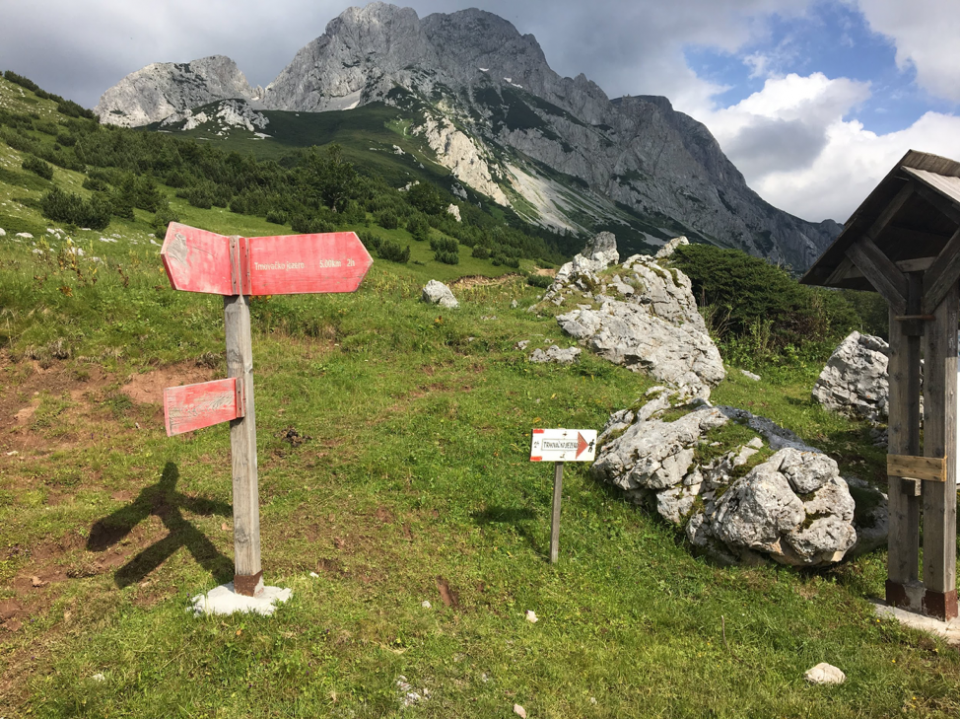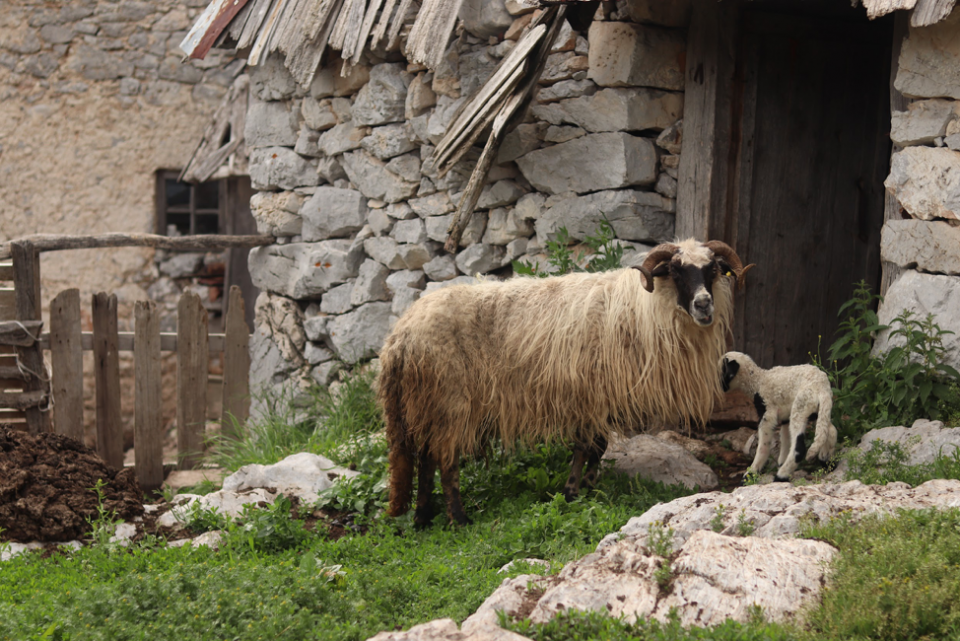
Much of the fighting that took place during the Bosnian war of the 1990s occurred in the country’s mountains, hills, and countryside. Once littered with landmines that led to the destruction and decay of the hiking trails and mountain huts that served to connect the country and its people, Bosnia and Herzegovina is now re-establishing itself as a hub for outdoor and adventure tourism as it invites people to return to its mountains to enjoy the beautiful scenery of the Dinaric region.
History of Mountaineering in BiH
Today, approximately a third of Bosnia and Herzegovina’s population is involved in mountaineering to some extent — ranging from committed mountaineers to those who get out and hike at least once a year. But mountaineering has experienced some significant changes over the past 30 years and the effects of the war in the 1990s still remain visible in both the city and the countryside.
During the time of Yugoslavia, mountain trails were interconnected and paths were clearly marked. There was an extensive network of mountain huts and lodges and everyone worked together to create a cohesive system. This all fell apart after the break-up of Yugoslavia and the war that ensued. With the dissolution of the former system, mountaineering has seen staggered growth in recent years. Many mountain huts and lodges were destroyed and, according to mountaineer Dalvin Kadirić of PD Željezničar Sarajevo, there is no longer one mountaineering union that represents each society and the mountaineering unions in BiH have struggled to adapt to the new conditions, which has resulted in a decrease in mountaineering association memberships.
“In earlier times, there was one mountaineering society in (each) country and one mountaineering union that served to represent all the different mountaineering societies that existed across the region,” Kadirić said. He went on to explain that although BiH has a national union – the Mountaineering Union of Bosnia and Herzegovina – it consists of three sub-unions: the Mountaineering Union of the Federation of Bosnia and Herzegovina, the Mountaineering Union of Republika Srpska, and the Mountaineering Union of Herceg Bosnia. Unfortunately, these internal divisions have made efforts to re-invigorate this particular area of BiH’s outdoor tourism a bit more complicated.
Despite the complications, mountaineering associations like PD Željezničar Sarajevo are doing their best to navigate the political obstacles and Kadirić remains optimistic that the country’s strong tradition of mountaineering will continue. “I think we are on a good path towards reinvigorating the population’s passion for mountaineering by offering something new,” he said.
Kadirić explained that the purpose of PD Željezničar Sarajevo, which has been around since 1950, is to provide people with opportunities to connect with other mountaineers, volunteer for the organization, and venture out into the mountains. The non-governmental organization not only provides these opportunities but also participates in a number of other important activities, including trail clean-up, restoration, and marking. The organization takes care of the trails in its municipality and leads monthly hiking trips, service trips, and more. In addition, the group has been involved in the Via Dinarica Project since its outset.

Story of the Via Dinarica
The Via Dinarica is a mega-hiking trail spanning seven Western Balkan countries from Albania to Slovenia. The project has been in the works for years and development of such an expansive, cross-country trail is no small task, especially when considering the region’s rocky past.

“Our aim was to explore the potential to connect point A to B to C to Z and so forth, as well as whether it was possible for one to walk the entire route. We were, of course, expecting to encounter some obstacles along the way,” Via Dinarica’s project manager, Božana Kaltak, said. “We were expecting to run into some neglected, and even non-existent, trails as a result of the region’s recent past,” she explained. However, Kaltak and her colleagues were hopeful that developing this mega trail would put the region on the international tourism map.
Following the war, there was a good deal of fear upon returning to the trails because of the large number of landmines that were still scattered across the country. According to a report by the Organization for Security and Co-operation in Europe’s Mission to BiH (OSCE BiH), more than 300,000 square kilometers have been cleared of mines since 1996, however, although only 2.2 percent of the country’s landmass remains hazardous, it is estimated that 80,000 landmines are still buried. Many trails still exist in areas that haven’t been mined, but the trails that are currently in active use are mine free, and, thus, hiking in the region is generally safe. In addition, most documented mine-related accidents are not associated with hiking.
Many parties have supported the realization of the Via Dinarica project, including the United Nations Development Programme (UNDP) in BiH, which has helped various mountaineering associations and NGOs clean up and mark trails, eliminating any major safety concerns associated with venturing back out into the mountains.
Kadirić said marking and clearing trails results in a feeling of accomplishment. “It’s always interesting, it’s complicated, and it’s an adventure. It’s hard for me to explain it in a few words, but you get the sense that you are leaving something behind for other people to enjoy – for other mountaineers, and for people who love nature. It is a really good feeling.”
Following these tasks, the next goal was to reconstruct mountain huts and improve or establish other tourism infrastructure to expand services and increase capacities. Similarly, USAID took part in the project, thus far contributing around USD 900,000 to the development efforts said Vladimir Milan of USAID in BiH.
“Thus far, we’ve helped develop the minimum kind of infrastructure necessary. First, the trails must be marked, so we marked approximately 3,000 kilometers of trails,” Milan said. “You also need to certify that there are no mines along these trails. We then provided assistance with the operation of some of the facilities along the trails such as mountaineer huts and bed and breakfasts.”
In March 2019, it was announced that another USD 2.7 million investment will be made toward the Via Dinarica project by USAID, the Italian Agency for Development Cooperation (AICS), and the Ministry of the Environment and Tourism FBiH. Some of the key project activities over the next two years will include the marking of an additional 500 km of trails along the Dinaric Mountains and the inclusion of new local communities.
Coming Together Under a United Cause
Because the Via Dinarica spans so many countries, stakeholders from across the Balkans have come together to realize the project. Often, the private sector proves more eager and cooperative to collaborate on such projects, but the public sector has demonstrated a willingness to join in.
“There is a very strong awareness on both sides (public and private sectors) that they must work hand in hand,” said Snježana Derviškadić, project leader of the Regional Cooperation Council in BiH’s Tourism Development and Promotion initiative.
According to the Via Dinarica Project’s project manager, Božana Kaltak, relevant ministries of tourism in BiH are among those within the public sector that have recognized the potential of the mega trail and have provided their support. The three main institutions supporting the project include the Ministry of Foreign Trade and Economic Relations of the State of Bosnia-Herzegovina, the Federal Ministry of Environment and Tourism, and the Republika Srpska Ministry of Trade and Tourism.
“So, the top three institutions dealing with tourism immediately got involved and provided support, recognizing the potential for outreach to the rural areas and the opportunities for touristic and sustainable development in these areas,” Kaltak stated.
Green Visions co-founder, Thierry Joubert said, “One of the key successes of the Via Dinarica is the willingness from different groups to say, ‘Okay, it clear that we are working towards the same goal, so let’s open up. Let’s just be human and come together. Sometimes the parties agree and sometimes they don’t, however, they all realize the importance of working together.”
Joubert helped establish the Via Dinarica Alliance – a group of outdoor adventure agencies from the Western Balkans who work together to provide the best Via Dinarica experience for travelers and tourists. The alliance is a model of how groups from countries that previously experienced serious conflict can put aside their differences and come together for a greater cause.
“One of the main reasons for establishing the Via Dinarica Alliance is that we understood the uniqueness of the project,” Joubert said. “The trail existed before officially becoming the Via Dinarica as there was a great deal of hiking going on in former Yugoslavia. You could hike all the way from Slovenia to Macedonia. In 2006, we saw that people had begun to return to the trail – local people,” he explained.
Once Joubert and others realized people were still going to the trail, it also became evident that the redefined country borders now served as a source of discontinuity.
“Some of the policy issues that became the big bear in the room were those related to visas and border crossings,” said Derviškadić. She explained, however, that different groups have been working together to raise these issues with relevant ministries in each respective country as the Via Dinarica continues to develop.
“There are still so many factors involved — there is politics, there is pain, there are emotions,” Joubert said. “I believe it was in 2016 when the different parties started to realize that we could again work together towards the same ideals and goals.”
Members of the Via Dinarica Alliance like Joubert, Derviškadić, and other outdoor adventure enthusiasts share a common passion for sport and the outdoors and have recognized a similar passion in both locals and tourists alike.
“If you tap into that passion, barriers basically cease to exist. People talk to each other as biker to biker or as a climber to climber — the fact that they have different passports is something that fades into the background,” Derviškadić said.

Future of Tourism in BiH
“As a result of everything that happened in the 1990s, we somewhat entered into the 2000s with a not so positive outlook,” Derviškadić said. “But I think things have been changing…the region overall is emerging, particularly in the adventure travel arena.”
After many years of working in the tourism industry, Derviškadić is excited about the prospects of adventure tourism in BiH. She said that tourists are becoming more environmentally conscious and are seeking more cultural opportunities to learn about local communities and customs. Luckily, BiH is rich in beautiful landscapes, untouched nature, and deeply rooted cultural traditions.
So, despite the region’s turbulent past, outdoor and adventure tourism is providing advantageous prospects for BiH’s economic future. According to USAID’s Vladimir Milan, even locals are now venturing out and doing day trips and overnights in the mountains. Thus, foreign tourists and locals alike are turning to the mountains and benefiting, and the rise in adventure tourism and ecotourism is not only benefiting the tourism sector but also local business owners and those living in rural areas.
“As long as the people there are making some money, as long as outdoor and healthy lifestyles are becoming more popular to the people of this country, and as long as more and more people are ending up in the mountains and out on the trails, it’s a good thing,” Milan said. “There’s a public benefit from the additional revenues, especially in those remote areas.”

Božana Kaltak agrees with Milan that one great benefit of the Via Dinarica’s development is the positive feedback they are receiving from the locals. “When you see how happy the people who are living in really rural mountain areas are when you come and offer them an opportunity to earn money off the resources that the generations before them lived off of, they are so happy. They are happy that someone is finally helping them to continue to live where they were born, or even to return, and earn some money from the food they produce and from the nature that they are surrounded by,” Kaltak said.
Hiking guide at the Rafting Center Drina-Tara, Dragan Bošković, said the area he works in is still largely undiscovered by the outside world. He said the nature is intact and the local food is organic, which is alluring to foreign visitors.

Kristian Milosavljević, also a guide at the Rafting Center Drina-Tara, has been working in the outdoor tourism field for 12 years. He explained that when the business first began, the majority of visitors were from ex-Yugoslav countries, but, thanks to the Internet, more and more visitors from foreign countries are arriving each year. “There are a lot of people that don’t know rafting in Bosnia even exists, so when they see it on the Internet, they want to try it.”
Milosavljević views rafting as a team building activity that bonds people despite their backgrounds. “We get a lot of people with different nationalities and religions, but none of that matters on a rafting expedition where we all work as a team to have fun,” he said. “A lot of people ask us if we ever get bored of this job, I’ve been doing it for 12 years now, and I never get bored because I have a new group of tourists every day, so no day is the same as the one before it and that’s the beauty of it.”
Milosavljević hopes that in the future the government will pay more attention to ecotourism and its implications for the country’s economy and will support the growing industry. Ultimately, projects like the Via Dinarica serve to unite people of all ethnicities, nationalities, and religions under one purpose: to share and preserve the natural beauty the region has to offer. Despite political, social, or economic divides, people can come together, reconcile their differences, and build something beautiful together.
__________________________________________________________________________________
For more on the social significance of mountaineering in Bosnia and Herzegovina, see “Bosnia in Hiking Boots: A History of Mountaineering Clubs” (2015) by Maria Hetman.






